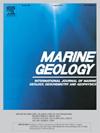Tracking coccolithophore productivity trends over the last 22,000 years: insights from sediments of IODP Expedition 385 in a high-productivity oceanic basin (Guaymas Basin)
IF 2.2
3区 地球科学
Q2 GEOSCIENCES, MULTIDISCIPLINARY
引用次数: 0
Abstract
We study sediment cores retrieved during International Ocean Discovery Program (IODP) Expedition 385 to gain a deeper understanding of the Guaymas Basin's (GB) response to climate fluctuations over the past 22,400 years by analyzing coccolithophore assemblages and estimating net primary productivity (NPP). Coccolithophore-based data and the NPP at IODP Hole 1549 A reveal that the GB consistently remained an area of high productivity throughout the studied time interval, with an average productivity value of 1288.25 mgC m−2 day−1, with a gradually declining trend towards the present.
Three main intervals are defined: (I) Cold, high productivity and vertically mixed surface waters during the Last Glacial Maximum and Heinrich Event 1 (22,400–15,320 cal yr BP), suggested by elevated net primary productivity (NPP), high abundance of Gephyrocapsa oceanica, and the presence of Coccolithus pelagicus subsp. braarudii. These conditions may be related to the incursion of the California Current Water into the GB. (II) Intermittent stratification with a deep position of the nutricline and thermocline during Bølling-Allerød, Younger Dryas, and broadly, the beginning of the Holocene (15,320–11,200 cal yr BP) indicated by an increase in relative abundance of Florisphaera profunda and the decrease in key coccolithophore taxa (notably G. oceanica and C. pelagicus subsp. braarudii). (III) Recurrent events of low productivity, warm surface water conditions with stratification since the beginning of the Holocene Climatic Optimum (11,200 cal yr BP-present), as suggested by the dominance of warm and oligo-mesotrophic water taxa (Helicosphaera spp., Calcidiscus leptoporus, Syracosphaera spp. and Umbilicosphaera sibogae) alongside a rise in F. profunda. From approximately 4900 cal yr BP to the present sustained stratification and declining NPP suggest the onset and intensification of modern monsoonal dynamics in the GB.
跟踪过去22000年的球石藻生产力趋势:来自高生产力海洋盆地(瓜伊马斯盆地)IODP 385考察沉积物的见解
我们研究了国际海洋发现计划(IODP) 385号考察期间获取的沉积物岩心,通过分析球岩石组合和估算净初级生产力(NPP),深入了解瓜伊马斯盆地(GB)过去22400年对气候波动的响应。球石藻数据和1549 A孔的NPP表明,在整个研究时间间隔内,GB始终是一个高生产力区域,平均生产力值为1288.25 mgC m−2 day−1,并逐渐下降。(1)末次盛冰期和海因里希事件1 (22,400-15,320 cal yr BP)期间,净初级生产力(NPP)升高,Gephyrocapsa oceanica丰度高,cocolithus pelagicus亚种存在,表明表层水冷、高生产力和垂直混合。braarudii。这些情况可能与加利福尼亚水流侵入英国有关。(II)新仙女木期(b øllin - allero ød)和全新世初期(15320 - 11200 cal yr BP)营养线和温跃层处于较深位置的间歇分层,表明Florisphaera profunda的相对丰度增加,而主要的球石藻类群(特别是G. oceanica和C. pelagicus亚种)的相对丰度减少。braarudii)。(III)自全新世气候最适期(距今11200 cal yr)开始以来,低生产力、温暖的地表水条件和分层反复发生,这表明温暖和少中营养水分类群(Helicosphaera spp., Calcidiscus leptoporus, Syracosphaera spp.和脐带osphaera sibogae)的优势以及F. profunda的增加。从大约4900 calyr BP到现在的持续分层和NPP的下降表明现代季风动力学在GB的开始和加强。
本文章由计算机程序翻译,如有差异,请以英文原文为准。
求助全文
约1分钟内获得全文
求助全文
来源期刊

Marine Geology
地学-地球科学综合
CiteScore
6.10
自引率
6.90%
发文量
175
审稿时长
21.9 weeks
期刊介绍:
Marine Geology is the premier international journal on marine geological processes in the broadest sense. We seek papers that are comprehensive, interdisciplinary and synthetic that will be lasting contributions to the field. Although most papers are based on regional studies, they must demonstrate new findings of international significance. We accept papers on subjects as diverse as seafloor hydrothermal systems, beach dynamics, early diagenesis, microbiological studies in sediments, palaeoclimate studies and geophysical studies of the seabed. We encourage papers that address emerging new fields, for example the influence of anthropogenic processes on coastal/marine geology and coastal/marine geoarchaeology. We insist that the papers are concerned with the marine realm and that they deal with geology: with rocks, sediments, and physical and chemical processes affecting them. Papers should address scientific hypotheses: highly descriptive data compilations or papers that deal only with marine management and risk assessment should be submitted to other journals. Papers on laboratory or modelling studies must demonstrate direct relevance to marine processes or deposits. The primary criteria for acceptance of papers is that the science is of high quality, novel, significant, and of broad international interest.
 求助内容:
求助内容: 应助结果提醒方式:
应助结果提醒方式:


